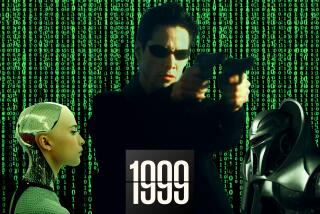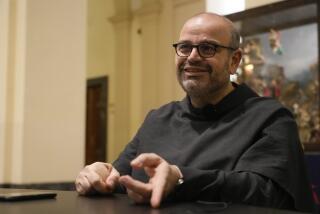Software Research Taps Metaphysics
- Share via
For now, you won’t find any French deconstructionists working at the new IBM/Apple joint venture. Sony, Matsushita and NEC--who have collectively spent billions of yen exploring every facet of multimedia software design--have yet to hire a single phenomonologist. But just wait a year or two.
Increasingly, the most exciting areas in software research--virtual reality, artificial life and artificial intelligence--are being shaped as much by metaphysics as by silicon physics. Seminal papers are now populated with references to philosophers ranging from Wittgenstein to Derrida. The design of a computer-constructed “virtual reality” is just as likely to draw inspiration from the philosophical musings of an Umberto Eco or a Jean Braudillard as any technical breakthroughs.
“It’s amazing how the virtual reality dialogue has brought people out of the woodwork in philosophy,” observes Brenda Laurel, a founding partner of Telepresence Research, a California-based virtual reality design firm.
Historically, there’s nothing new about a robust dialogue between computer technologists and philosophers--particularly in the realm of artificial intelligence. Philosophers such as the University of California’s John Searle and RAND Corp.’s Hubert Dreyfus were like theater critics panning the performances of computer programs purporting to emulate “thought” and “the mind.” Both sides delighted at sniping at the intellectual pretensions of the other.
But over the past decade, both the technology and the discourse increased in sophistication. As a result, technological design and philosophical inquiry are no longer on parallel paths. They’ve converged. Indeed, the more complexity, choice and opportunity a technology creates, the more it draws upon genuine philosophical inquiry as a design resource. The real future of software design will lie more in philosophy than in engineering.
“I’m worried that some people might think these are fads rather than genuine attempts to go for the root of things,” says John Seely Brown, who runs Xerox’s influential Palo Alto Research Center, one of the world’s pioneering computer laboratories. “But you know, you can’t build a learning organization with a brain-dead theory of knowledge.”
Brown, a physicist who also gives seminars with titles such as “Post Modernism and Organizational Architecture,” argues that the technology is now reaching the stage where his technologists have to start asking the questions philosophers would ask, and that philosophers now have a medium to test some of the ideas they’ve been expounding.
“There is a shift in the science,” agrees Danny Hillis, the brilliant computer architect who designed the Connection Machine, a computer that literally links tens of thousands of processors, like neurons, into a giant, high-speed computational network. “The (traditional) sequential computer fooled people into thinking that there was the linear, causal path and that the world could be constructed out of logical axioms. It turned out that biology and consciousness never fit into that model. Today, parallel computers offer a much more complex model . . . a tool that lets us answer questions and bring them out of the domain of philosophy.”
That’s not to say that reading German philosopher Martin Heidegger makes one a better programmer, cautions Hillis, but there’s little question that philosophers and the designers of virtual realities and artificial life forms are now confronting the same questions.
In fact, computer software is already being transformed by such epistemological entrepreneurs. Stanford University computer science professor Terry Winograd, once an early champion of traditional artificial intelligence research, began exploring Heidegger’s approach to the role of language in making commitments and contracts. Ultimately, his work grew into The Co-ordinator, a very successful, albeit controversial, computer network software package that enabled people to coordinate their work schedules and activities. The Co-ordinator wasn’t just designed to manage information, it was designed to manage the language of work.
“That was technology guided by philosophy,” Winograd says. In essence, says Bart Kosko, an assistant professor of electrical engineering at USC and a champion of “fuzzy logic”--a mathematical approach that refutes the Aristotelian dogma of absolutes--the limits and potential of computer technology are now being determined by philosophical assumptions of the designers. People who design software under the influence of fuzzy logic or Heidegger’s concept of language are going to end up with radically different systems as surely as you end up with different economies if you start out with the assumptions of a Karl Marx or an Adam Smith.
“Remember that quote from (the economist John Maynard) Keynes,” says Kosko, who majored in philosophy. “ ‘Practical men, who believe themselves to be quite exempt from any intellectual influences, are usually the slaves of some defunct economist. Madmen in authority, who hear voices in the air, are distilling their frenzy from some academic scribbler of a few years back.’ ”
There’s no dominant design philosophy shaping the virtual realities and artificial lives and minds of tomorrow. There may just be a constant turmoil of competing philosophies. But the emerging reality is that, for better or worse, the future of technology is going to be the future of philosophy.






